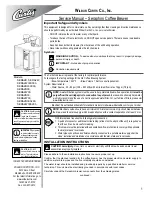
26
GUIDE TO MIG/MAG WELDING
Before starting any welding activity ensure that you have suitable eye protection and
protective clothing. Also take the necessary steps to protect any persons within the welding
area.
Notes for the welding beginner
This section is designed to give the beginner who has not yet done any welding some information to get
them going. The simplest way to start is to practice by running weld beads on a piece of scrap plate. Start
by using mild steel (paint free) plate of 6.0mm thick and using 0.8mm wire. Clean any grease, oil and loose
scale from the plate and fix firmly to your work bench so that welding can be carried out.
Make sure that the work return clamp is secure and making good electrical contact with the mild steel
plate, either directly or through the work table. For best results always clamp the work lead directly to
the material being welding, otherwise a poor electrical circuit may create itself.
MIG/MAG process features and benefits
Terms used:
MIG
-
Metal Inert Gas Welding,
MAG
-
Metal Active Gas Welding,
GMAW
-
Gas Metal Arc Welding
MIG welding was developed to help meet production demands of the war and post war economy which
is an arc welding process in which a continuous solid wire electrode is fed through a MIG welding
gun and into the weld pool, joining the two base materials together. A shielding gas is also sent through
the MIG welding gun and protects the weld pool from contamination which also enhances the arc.
The MIG/MAG process can be used to weld a wide variety of materials and is normally used in the
horizontal position but can be used in vertical or overhead with the correct selection of machine, wires
and current. In addition, it can be used to weld at long distances from the power source subject to the
correct cable sizing.
It is the dominant process used in maintenance and repair industries and is used extensively in structural
and fabrication work.
Weld quality is also highly dependent on the skill of the operator and many welding problems can exist
due to incorrect installation application and use.
Welding position
When welding, ensure you place yourself in a comfortable position for welding and your welding
application before you begin to weld. This maybe sitting at a suitable height which often is the best way
to weld ensuring you
’
re relaxed and not tense. A relaxed posture will ensure the welding task becomes
much easier.
Please ensure you always wear suitable PPE and use suitable fume extraction when welding.
Place the work so that the direction of welding is across, rather than to or from your body. The electrode
holder lead should always be clear of any obstruction so that you can move your arm freely along as the
electrode burns down. Some elders prefer to have the welding lead over their shoulder, this allows
greater freedom of movement and can reduce the weight from your hand.
Always inspect your welding equipment, welding cables and electrode holder before each use to ensure
it
’
s not faulty or worn as you may be at risk of an electric shock.
















































